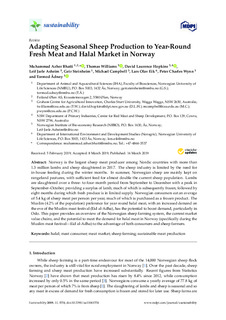| dc.contributor.author | Bhatti, Muhammad Azher | |
| dc.contributor.author | Williams, Thomas | |
| dc.contributor.author | Hopkins, David Laurence | |
| dc.contributor.author | Asheim, Leif Jarle | |
| dc.contributor.author | Steinheim, Geir | |
| dc.contributor.author | Campbell, Michael | |
| dc.contributor.author | Eik, Lars Olav | |
| dc.contributor.author | Wynn, Peter Charles | |
| dc.contributor.author | Ådnøy, Tormod | |
| dc.date.accessioned | 2019-07-02T07:21:08Z | |
| dc.date.available | 2019-07-02T07:21:08Z | |
| dc.date.created | 2019-03-15T15:23:23Z | |
| dc.date.issued | 2019 | |
| dc.identifier.issn | 2071-1050 | |
| dc.identifier.uri | http://hdl.handle.net/11250/2603099 | |
| dc.description.abstract | Norway is the largest sheep meat producer among Nordic countries with more than 1.3 million lambs and sheep slaughtered in 2017. The sheep industry is limited by the need for in-house feeding during the winter months. In summer, Norwegian sheep are mainly kept on rangeland pastures, with sufficient feed for almost double the current sheep population. Lambs are slaughtered over a three- to four-month period from September to December with a peak in September–October, providing a surplus of lamb, much of which is subsequently frozen, followed by eight months during which fresh produce is in limited supply. Norwegian consumers eat an average of 5.4 kg of sheep meat per person per year, much of which is purchased as a frozen product. The Muslim (4.2% of the population) preference for year-round halal meat, with an increased demand on the eve of the Muslim meat festival (Eid al-Adha), has the potential to boost demand, particularly in Oslo. This paper provides an overview of the Norwegian sheep farming system, the current market value chains, and the potential to meet the demand for halal meat in Norway (specifically during the Muslim meat festival—Eid al-Adha) to the advantage of both consumers and sheep farmers. | nb_NO |
| dc.language.iso | eng | nb_NO |
| dc.rights | Attribution-NonCommercial-NoDerivatives 4.0 Internasjonal | * |
| dc.rights.uri | http://creativecommons.org/licenses/by-nc-nd/4.0/deed.no | * |
| dc.title | Adapting Seasonal Sheep Production to Year-Round Fresh Meat and Halal Market in Norway | nb_NO |
| dc.type | Journal article | nb_NO |
| dc.type | Peer reviewed | nb_NO |
| dc.description.version | publishedVersion | nb_NO |
| dc.source.volume | 11 | nb_NO |
| dc.source.journal | Sustainability | nb_NO |
| dc.source.issue | 6 | nb_NO |
| dc.identifier.doi | https://doi.org/10.3390/su11061554 | |
| dc.identifier.cristin | 1685184 | |
| cristin.unitcode | 192,10,1,0 | |
| cristin.unitcode | 192,13,1,0 | |
| cristin.unitname | Institutt for husdyr- og akvakulturvitenskap | |
| cristin.unitname | Institutt for internasjonale miljø- og utviklingsstudier | |
| cristin.ispublished | true | |
| cristin.fulltext | original | |
| cristin.qualitycode | 1 | |

